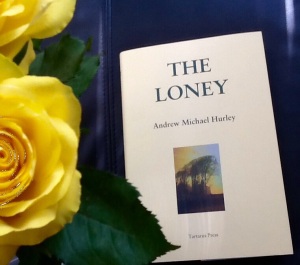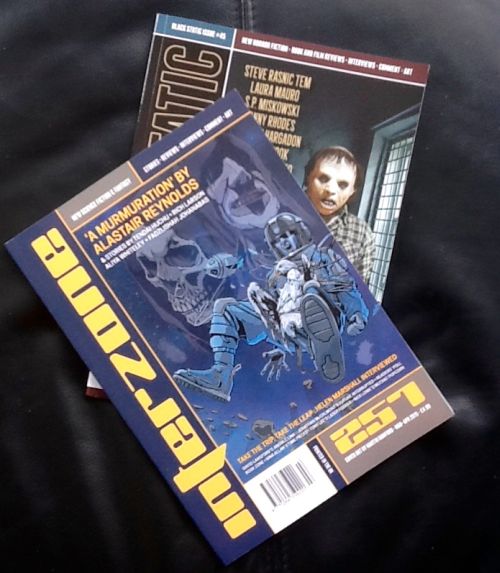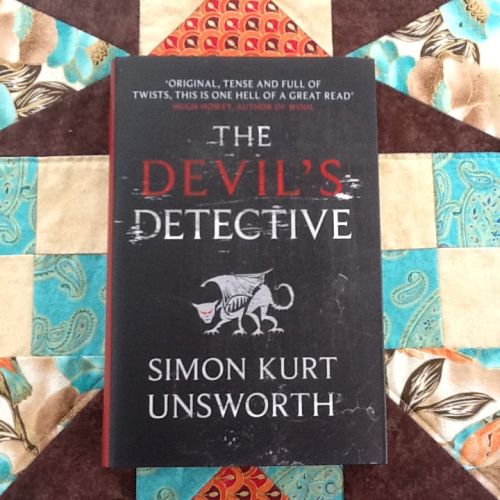And the relativities of Good and Bad.
My recent reviews: https://dflewisreviews.wordpress.com/2015/03/14/the-devils-detective/ https://dflewisreviews.wordpress.com/2015/03/25/the-loney-andrew-michael-hurley/

www.nemonymous.com
Des Lewis - GESTALT REAL-TIME BOOK REVIEWS
A FEARLESS FAITH IN FICTION — THE PASSION OF THE READING MOMENT CRYSTALLISED — Empirical literary critiques from 2008 as based on purchased books.


 The Frequency of Existence by Andrew Hook
The Frequency of Existence by Andrew Hook The Worshipful Company of Milliners by Tendai Huchu
The Worshipful Company of Milliners by Tendai Huchu
In my real-time reviewing since 2008, I rarely reveal, while reading a book, serendipities or synchronicities that cannot be checked independently. But this book starts with a gale connected to Parliament Hill only a half an hour after I was checking out (for a specific purpose) an old letter from a friend, a letter that I filed some years ago in which he talks about going for a walk and seeing people taking advantage of the wind on Parliament Hill by flying their kites. Then this book reveals its ‘genius loci’ with these words: “…but the locals called it The Loney — that strange nowhere between the Wyre and the Lune…”, and I recalled that that same friend once lived, while a student at Lancaster University in the late sixties, at Sunderland Point which, I vaguely recall, was also a sort of nowhere between the Wyre and the Lune, if not the same place as The Loney?
When I lived at Sunderland Point, it was reached via a tidal road. One of my closer approaches to death was on a night when I misjudged the state of the tide. Before I reached Sunderland Point, I was wading waist deep in fast flowing water. The circumstances would have only needed to be a little different for me to drown that night.
I believe that, since I last visited Sunderland Point (in the late 1960s), a non-tidal road has been built. As a result, I imagine, what was (in my time) a place more akin weird fiction than dull reality has probably been transformed into bijou housing for the middle classes — Lancaster University academics and other such nonsense. I find that a sad prospect, and rarely think on it.
“Perhaps being a priest was like being a fish. Immersion for life.”
It’s as if I am being pulled into a time-textured situation of a believable Catholic family, their priests, their Easter pilgrimages from London (to the Loney), a texture that needs working at and will no doubt need working back out to tell you of it. I don’t intend to itemise the plot as I proceed but mainly its effect upon me, and so far I am utterly fascinated by the narrator’s description of the earlier time when he was at the Loney, the down and out whom he and his brother Hanny met there when they were younger. And later the nature of Hanny himself, and I wonder how he developed from a child of special needs (I infer) to a pastor with a family and a published book behind him (I again infer). Feeling my way, but I am already enthralled.
“Only the water stains on the ceiling had grown. The dark patches had assumed the shapes of foreign countries, and a succession of tide lines showed how the empire of dampness had expanded year on year since we’d last been.”
The narrator, his well-characterised family and other members of the church and its new priest, (involving engaging references and nicknames like Matt Monro, the Lone Ranger, Tonto et al) travel back, after a number of years, to The Loney, on pilgrimage to its shrine, at least in some eyes, to help his brother Hanny’s muted condition, I infer. Without double-checking, I am not sure if we have even been made aware of the narrator’s own name? But we vividly experience, through his eyes, the rediscovery of this old haunt, the atmospheric old house, the ominous locals as if fresh from the Wicker Man, and listen to someone’s ‘confession’, via a triple barrier as it were of information channeled through various people, through the ad hoc confessional curtain, then through the thin bedroom wall, then through the paper wall of text itself (like Chinese whispers?)…
Having now set the story, as I see it so far, I shall now hopefully devote this review to impressions rather than condensed specifics!
Meanwhile, Lone(y) Ranger?
“I can’t seem to do or say anything without him making a note of it. I feel like a damn specimen.”
Nicknamed Tonto by this priest, the narrator who is addressed, I think, with only the surname Smith while his ostensibly defective brother is called Hanny (Andrew) Smith. Is the narrator really the narrator, i.e. ‘God’ of the book by some (T)ontology? The priest (the past priest as well as the present one on the current pilgrimage) is pervasive, as is The Loney’s ‘sense of place’ being artfully built up with the boys’ rediscovery of the ‘pillbox’ (another Word or Logos for a church or Hanny’s miracle cure?) with the remembered foil of Smith’s past attending a London church where he was ‘altar boy’. The old Loney house that is ‘primed’ like the land outside to have sudden unexpected turnings, now a secret room… One really gets to feel the nature of these various characters and of some pent up ominousness of others around, including the preening, sloping, spivvy family of three (one of them very young, wheelchaired and heavily pregnant) seen by the boys in the area. Matt Monro had the first hit with the famous song ‘Yesterday’, even before the Beatles. Here, his namesake is the priest’s Dog…
“The thing you have to remember about the tides here, is that no one can say they know them. Not really.”
…including the tides of this book’s narrative (intentional or not) or the various subjective tides of understanding the text by any single reader. The importance of suffering. The importance of not getting cut off by these tides – cut off by them from God (or drowned by them to ease our path towards Him), cut off from the inculcated past, or simply from our own self? And the empty coat hooks and smell of gabardine in the other house in this book, like a waft of Elizabeth Bowen, such as her brief story with the one word title of ‘Love’, or like a shade of Robert Aickman? A fragment or a fracturing.
“Hell was a place ruled by the logic of children.”
I hope I am not giving the impression this is an abstruse book from which one needs to dig out its symbolism, although it may also be that on the quiet. No, it is predominantly an easy evocative style that tells a page-turning story of a community’s various characters, mysteries, darknesses, effigies and ominous threats – threaded through with the backstory of Smith’s earlier London childhood when, say, onanism (Loneyism?) was punished by the priest with stinging nettles or threats of Hell. I have not yet gleaned any authorial or narrative slant on the Catholic ethos with which this story is imbued, one with vivid descriptions of Hell based on the local community’s Church of The Sacred Heart, a sense of the Eucharistic, the Confessionary, the Curative and the Penitential. This ethos just is. Beautifully if neutrally described. But I suppose this depends with what baggage any single reader actually brings to this book.
Meanwhile, I have been wondering why Smith calls his parents Mummer and Farther. The latter name would need to be spelt out in writing to differentiate it from Father as in Father Bernard or Father Wilfred.
“Perhaps they had got it wrong, or the old stories had succumbed to Chinese whispers as old stories do.”
Smith, as our presumably reliable narrator, often furthers the purposes of the plot by overhearing and reporting upon various makeshift confessions officiated by Father Bernard. And by this means we learn more of the backstory concerning his predecessor, Father Wilfred. Inferred money-laundering, ancient taxidermy and Hanny’s unrequited love, too. I am, of course, a reliable reviewer, but you will have to read this book to be absolutely sure. A book’s still mysterious world as ontology concerning the Existence of an Author who writes about God. Or from God. Or, even, as God.
“No one can have invented Hell. It’s like saying someone invented air. It’s just always been there.”
Backstory and frontstory, Fathers Wilfred and Bernard, London and Loney, Catholic and pagan, dumb innocence and wily awareness, local residents and their visitors, nearer and farther, icons and iconoclasts, sheep’s birthing or a young girl’s, primed and unprimed: each half of each equation finding the other lacking or inimical. The cross-currents increase, as Smith’s strictly devout Mummer welcomes in the Mummers across her threshold on Easter Day…
All gradually sizing up for Hanny’s planned visit to the shrine the next day…?
“We all need a rock to cling to in a storm.”
We all do indeed. But unsure a religion with miracles would work for me. We shall see if this book works its own miracle, a book as reliquary, naive narrative though it otherwise seems to be. The Mummers act a sort of Punch and Judy with real people inside the puppets as, unintentionally perhaps, they seem to enact the background to Isis State, Sullyman or Sillyman and Doctor Dog and Turkish knight. And later Hanny is prepared in the form of a Crusader, with makeshift relics in his tunic, primed, that is, for his long-trailered visit to the shrine… He expects something or someone Else? A Portrait of his Love or a Blessed Mary? And the priestly backstory via Smith’s account with its Mystery Plays now seems an overstory instead.
“‘Hanny, I said, ‘We’re going to see God.'”
“You know, not all miracles are instantaneous. I’ve never seen one like that anyway. I think it takes a while for them to ripen.”
…like this book that I begin to understand more and more, not back, front or over stories, but a palimpsest of stories, but if I told you exactly how or why, then that would be a massive spoiler. This book is ‘a tight kissing gate’, a vigil, a vision of a Purgatory or Limbo similar to that in ‘The Devil’s Detective’ book, a rosary of stiff paper pages in the version I hold, I guess. Not a Mummerset of a force-fed miracle, but an eking out of simple words reconciling unsimple meanings. Death like a waxwork, this section of the book says or implies. Or a taxidermist’s imagined version of an ancient hospice frozen in time?
“The only sound was that of fruit falling from the apple trees.”
…thump, thump, thump, as in Elizabeth Bowen’s famous ghost story. We’re now in resolution territory that can often spoil any book by giving too much easy information and demystification. And the still unfolding denouement embraces Bowen – and embraces even Blyton, with ‘Famous Five’ like villains at that other house where a baby cries, but the novel is saved by what I have long called disarming Aickmanisms, those ‘objective correlatives’ that thankfully for the reader fail to solve whether the miracle, if miracle it is, is the Devil’s work or God’s. A necessary blurring of truth that is the truth of fiction. As are the later repercussions for the book’s characters, devout and the doubting alike. Just like Father Bernard’s memory of his time in Belfast, where God and the Devil got confused as did the roads, and Loney-like by-ways. Just like the paths of this book itself… “Tonto, the truth isn’t always set in stone. In fact it never is. There are just versions of it. And sometimes it’s prudent to be selective about the version you choose to give people.”
“He thought of himself as a shepherd in one of those pre-Rapahelite paintings, drowsing under the dapple of an ancient tree,…”
We follow one of the two priests into the Wilderness (as prefigured, I vaguely recall, earlier in this book by Jesus in the Wilderness), this Wilderness based on the tidal uncertainties of the The Loney. The tides of ‘depravity’ that fight each with each to be more deprave? Or a test of faith that he fails? Each reader, perhaps will have his own answer depending on his own baggage. And then a coda, as, like the two Priests, the two brothers, one still Christian-nameless, swap over. A ‘childlike worldview’ of Heaven and Hell, but whose? Only and all fiction is childlike, not childish. Some more than others. And this book is at the perfect pitch of optimum, as well as pessimum, fiction as purgatory.
This review is dedicated to the Mummers of our world.
“Dog’ll eat whatever’s left.”
“For miracles are never seen.” – from Matt Monro’s ‘Portrait of my Love’